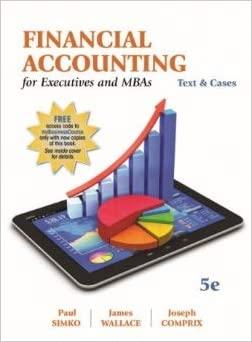Answered step by step
Verified Expert Solution
Question
1 Approved Answer
Long one but please assist! Kelvin Aerospace, Inc. manufactures parts such as rudder hinges for the aerospace industry. The company uses a job-order costing system

Long one but please assist!
Kelvin Aerospace, Inc. manufactures parts such as rudder hinges for the aerospace industry. The company uses a job-order costing system with a predetermined plant-wide overhead rate (POR) based on direct labor hours. On December 16, 2019, the company's controller made a preliminary estimate of the POR for the year 2020. The new rate was based on the estimated total manufacturing overhead cost of $3,402,000 and the estimated 63,000 total direct labor hours for 2020: POR $3,402,000 63,000 Hrs $54 per Direct Labor Hour The new rate was communicated to top managers in a meeting on December 19. The rate did not cause any comment because it was within a few cents of the 2019 overhead rate. One of the subjects discussed at the meeting was a proposal by the production manager to purchase an automated milling machine built by Miller Industries. The president of Kelvin Aerospace, Harry Arcany, agreed to meet with the sales representative from Miller Industries, Fran Brown to discuss the proposal. The following discussion took place: Arcany: Our production manager, Dan, has asked me to mete with you because he is interested in installing an automated milling machine. Frankly, I'm skeptical. You're going to have to show me that this isn't just an expensive toy for Dan's people to play with. Fran: This is a great machine with direct bottom-line benefits. There are 3 major advantages. First, it is much faster than the manual methods you are using. It can process about twice as many parts per hour as your present milling machines. Second, it is much more flexible. There are some up front programming costs, but once you have those incurred, almost no set up is required to run a standard operation. Arcany: What about cost? Having twice the capacity in the milling machine area won't do us much good. That center is idle much of the time anyway. Fran: I was getting there. The third advantage is the lower cost. Dan and I looked over your present operations, and we estimated that the automated equipment would eliminate the need for about 6,000 direct labor hours a year. What is your direct labor cost per hour? Arcany: The wage rate in the milling area averages about $32 per hour. Fringe benefits raise that figure to about $41 per hour. Fran: Don't forget your overhead. Arcany: Next year the overhead rate will be $54 per hour. Fran: So, including fringe benefits and overhead, the cost per direct labor hour is about $95. Arcany: That's right. Fran: Since you can save 6,000 labor hours per year, the cost savings would amount to about $570,000 per year. And our 60-month lease plan would require payments of only $348,000 per year. Arcany: That sounds like a no-brainer. When can you install the equipment? Shortly after this meeting, Mr. Arcany informed the company's controller of the decision to lease the new equipment, which would be installed over the holiday vacation period. The controller realized that this decision would require a re-computation of the POR for the year 2020 because the decision would affect both the manufacturing overhead and the direct labor hours for the year. After talking with both the production manager and the sale rep from Miller Industries, the controller discovered that in addition to the annual lease cost of $348,000, the new machine would also require a skilled technician/programmer who would have to be hired at a cost of $50,000 per year to maintain and program the equipment. Both of these costs would be included in the factory overhead. There would be no other changes in total manufacturing overhead cost, which is almost entirely fixed. The controller assumed that the new machine would result in a reduction of 6,000 direct labor hours for the year from the levels that had initially been planned. When the revised POR for 2020 was circulated among the company's top managers, there was considerable dismay. Required: 1. Re-compute the POR assuming that the new machine will be installed. Explain why the new POR is higher (or lower) than the rate that was originally estimated for 2020. 2. What effect (if any) would this new rate have on the cost of jobs that do not use the new automated milling machine? 3. Why would managers be concerned about the new overhead rate? 4. After seeing the new POR, the production manager admitted that he probably would not be able to eliminate all of the 6,000 direct labor hours. He had been hoping to accomplish the reduction by not replacing workers who retire or quit, but that had not been possible. As a result, the real labor savings would only be about 2,000 hours - one worker. Given this additional information, evaluate the original decision to acquire the automated milling machineStep by Step Solution
There are 3 Steps involved in it
Step: 1

Get Instant Access to Expert-Tailored Solutions
See step-by-step solutions with expert insights and AI powered tools for academic success
Step: 2

Step: 3

Ace Your Homework with AI
Get the answers you need in no time with our AI-driven, step-by-step assistance
Get Started


